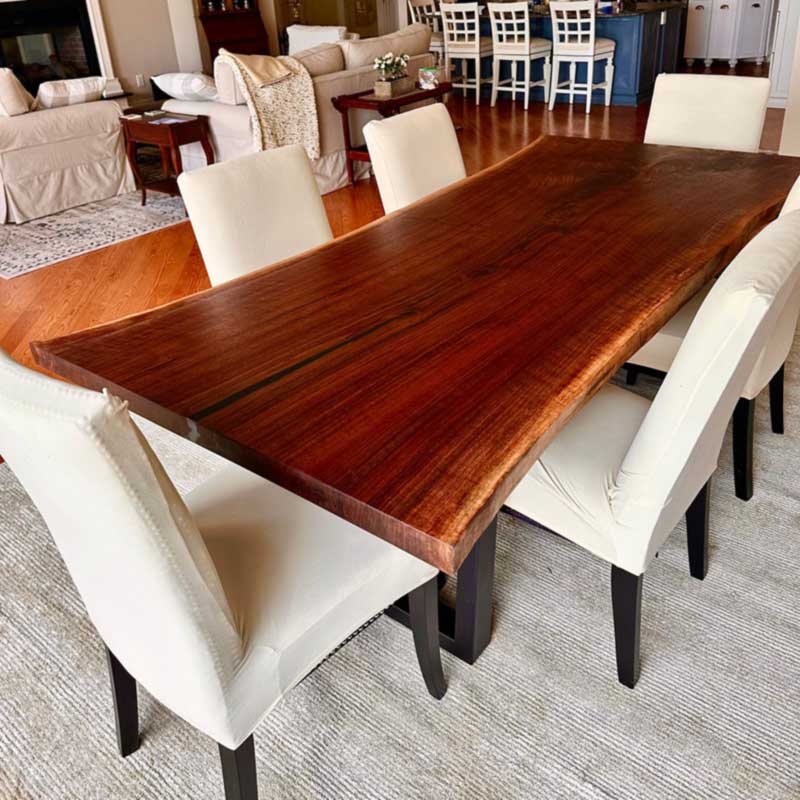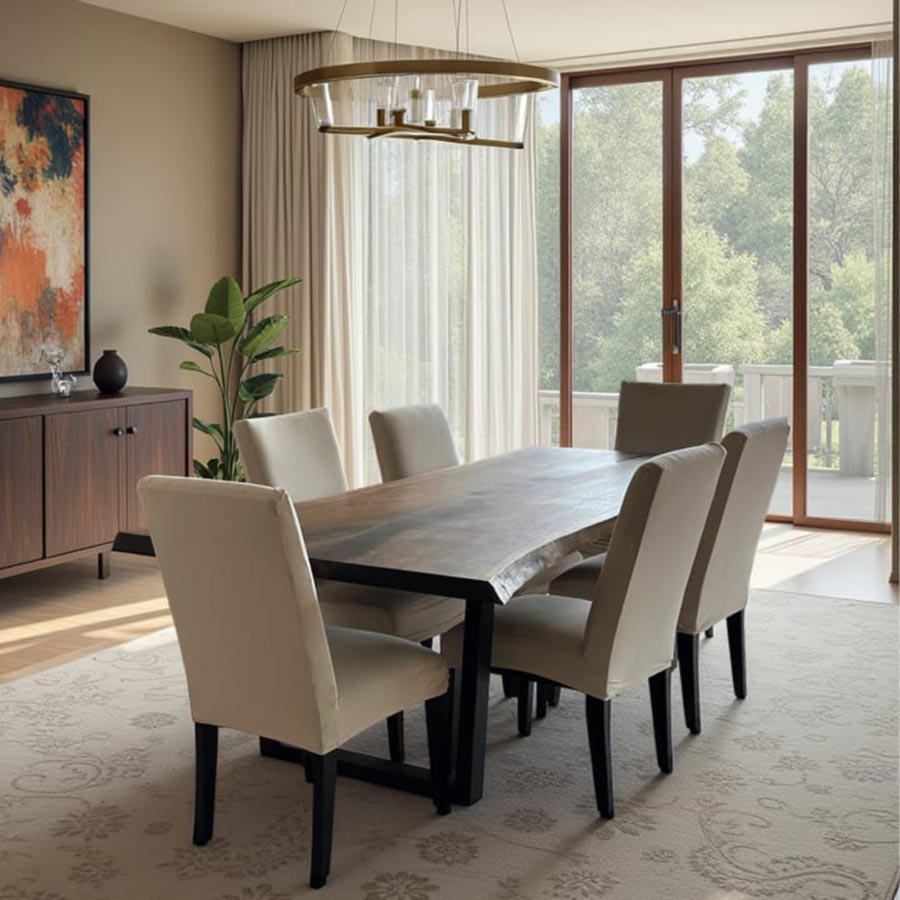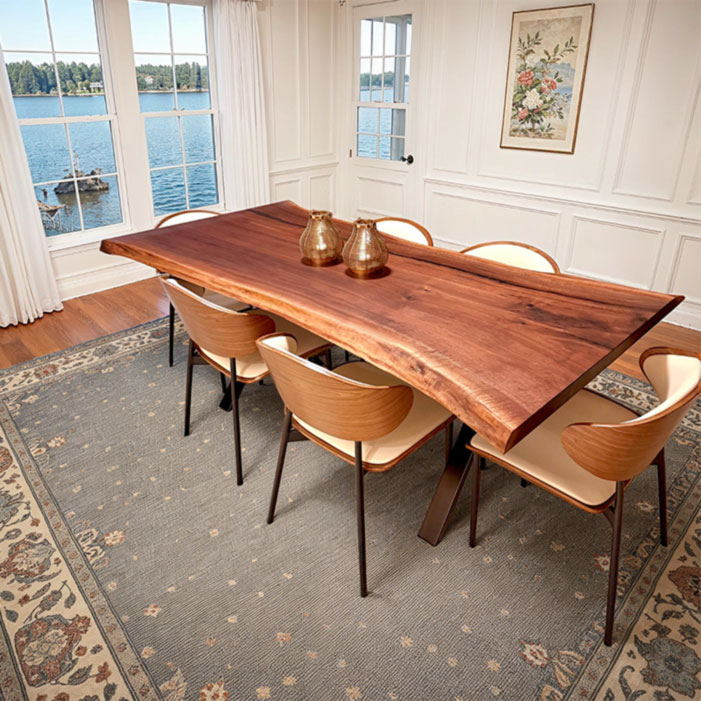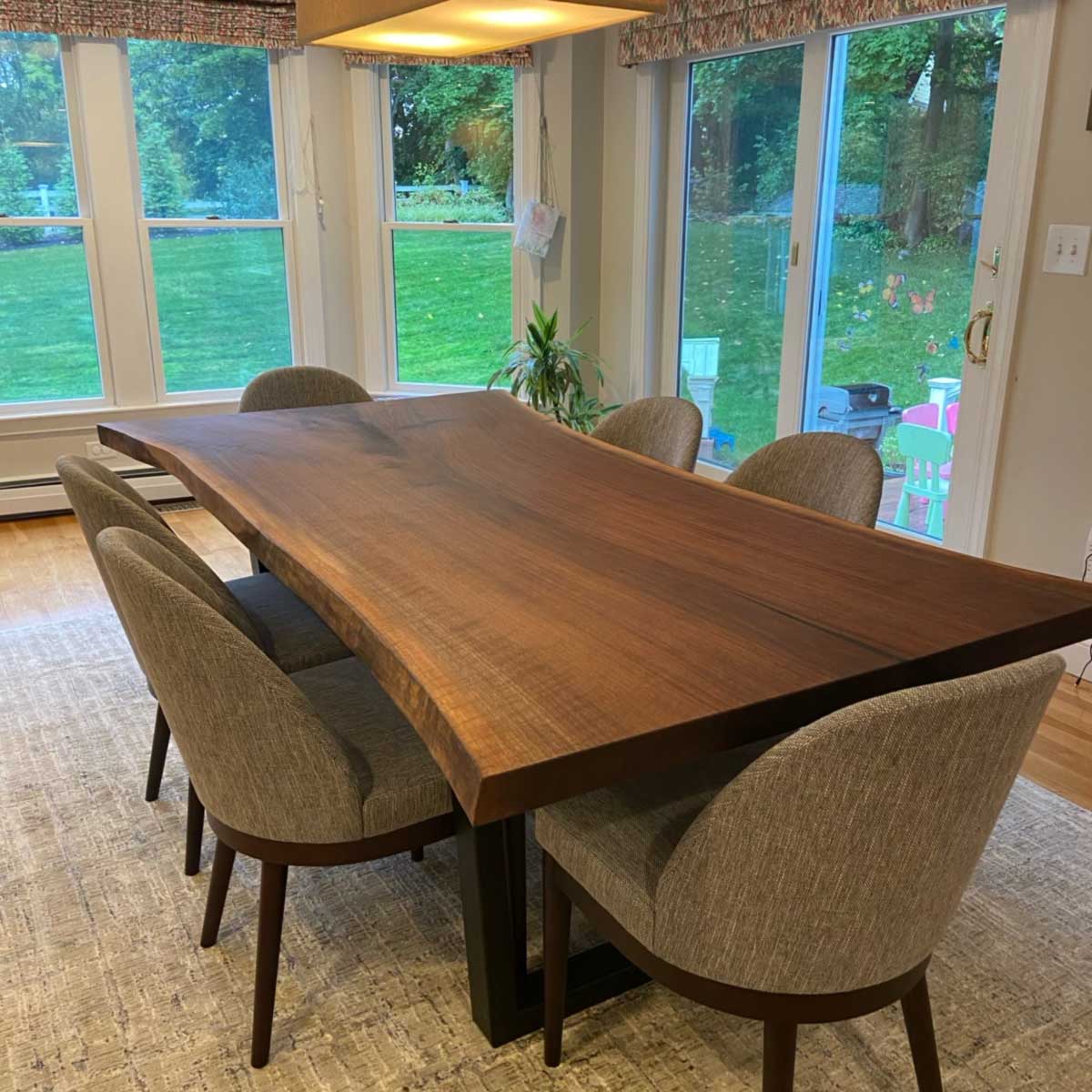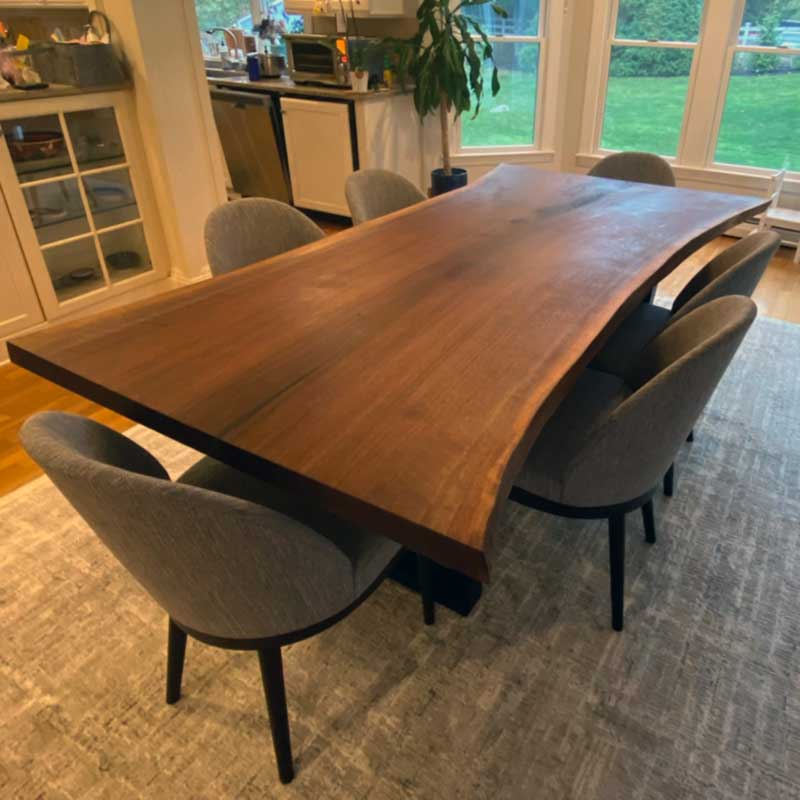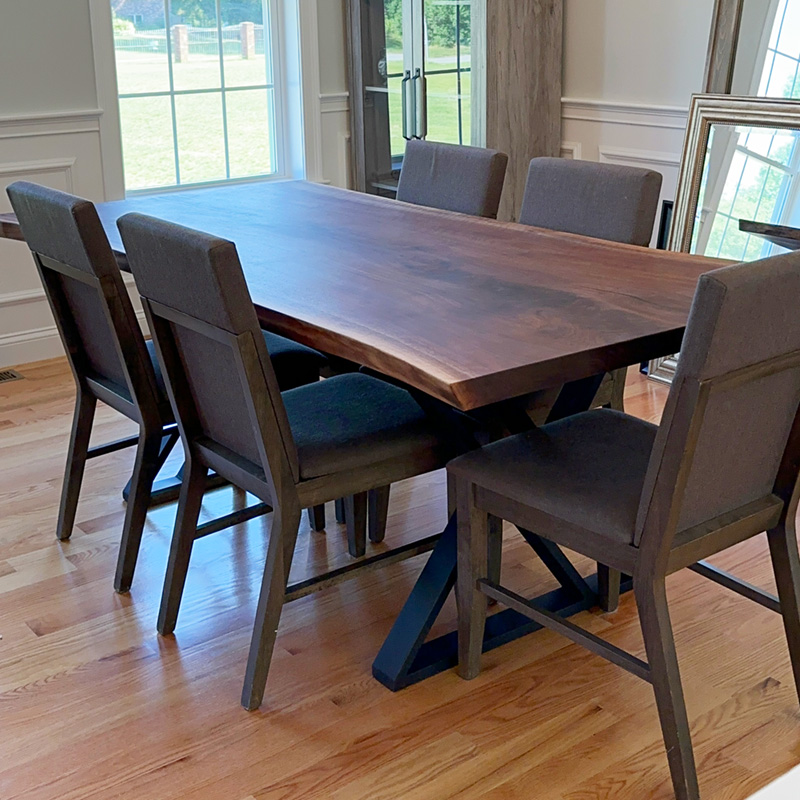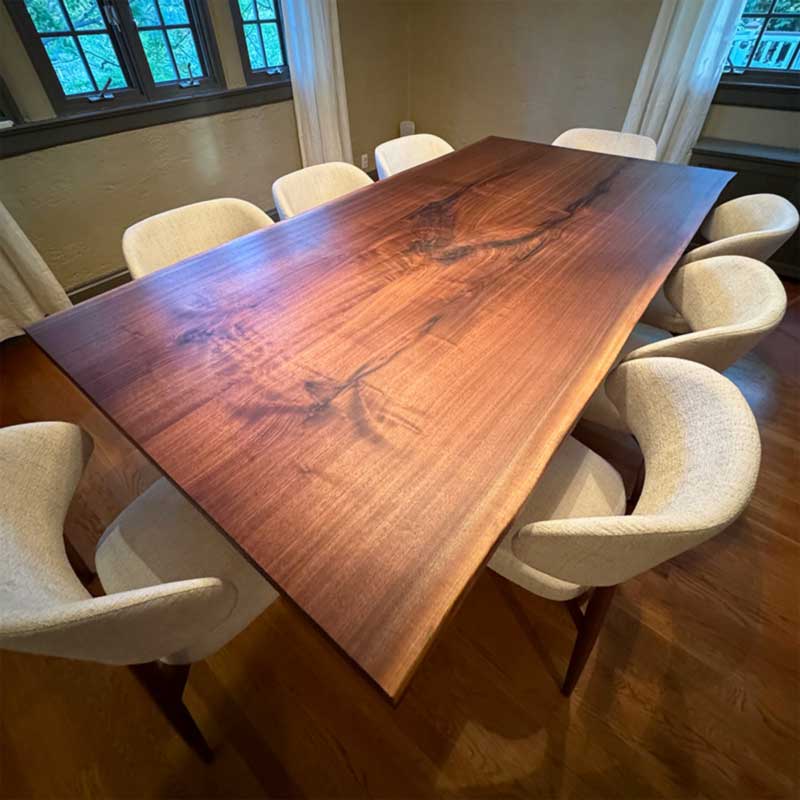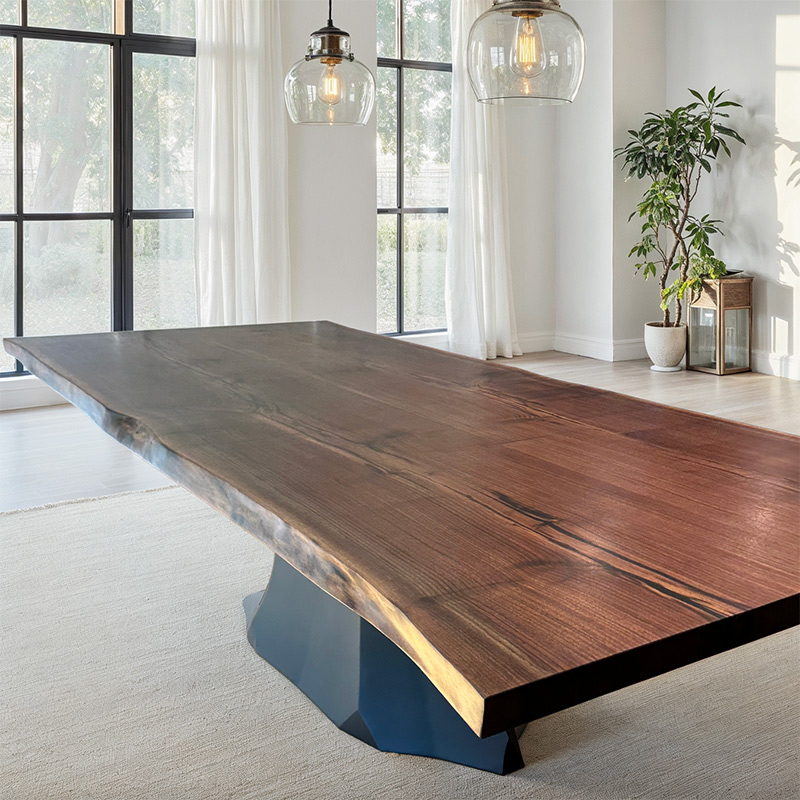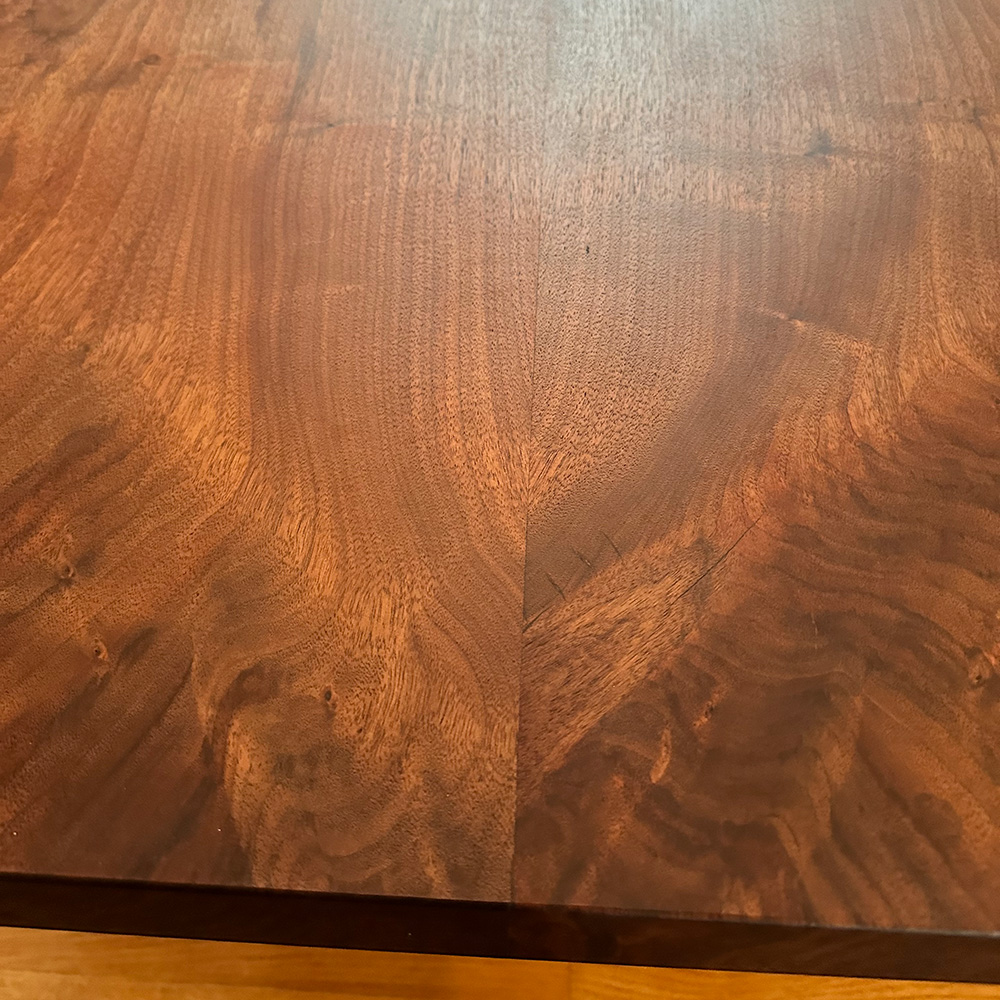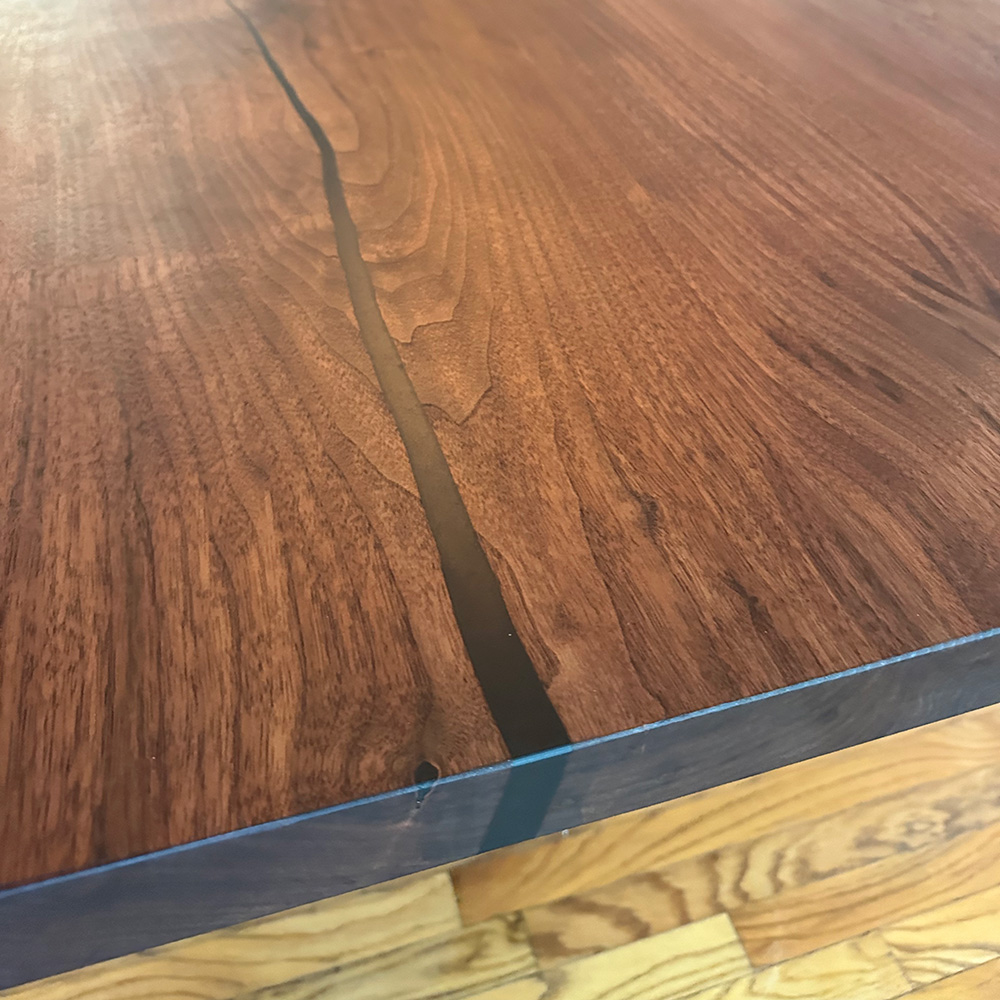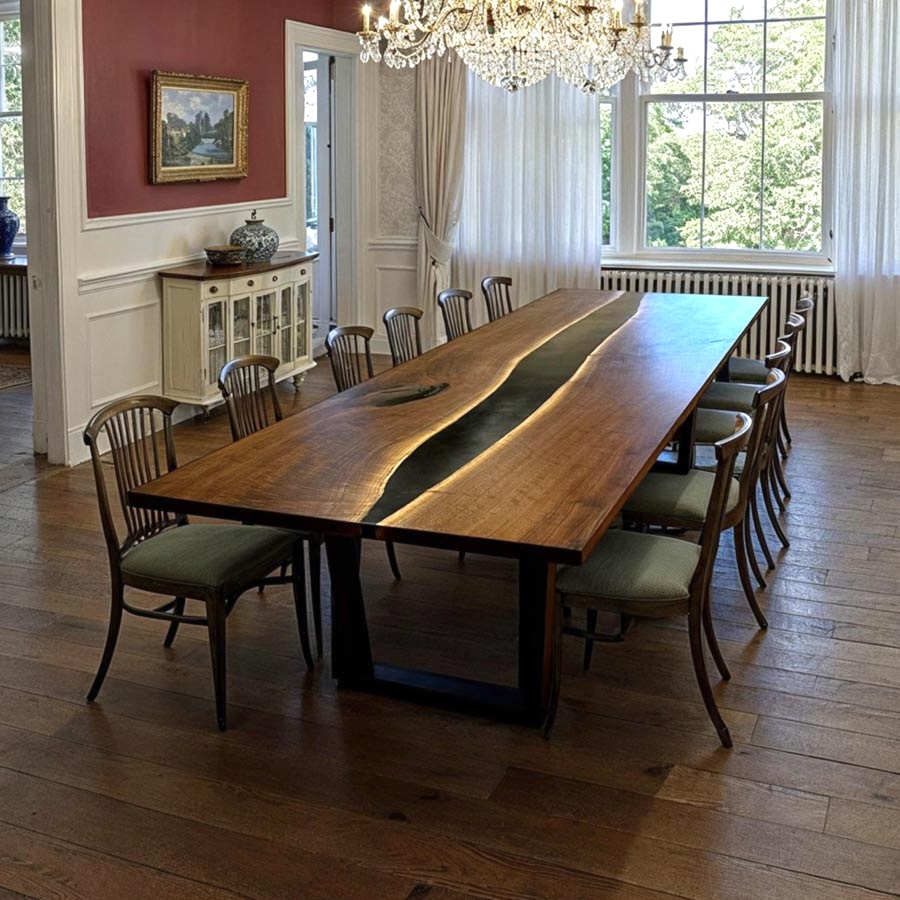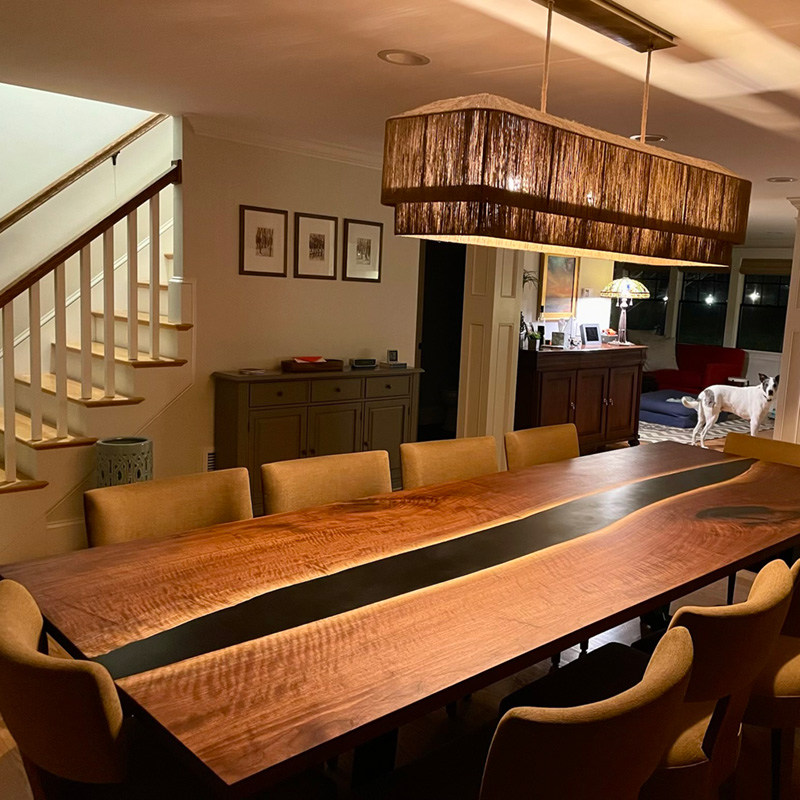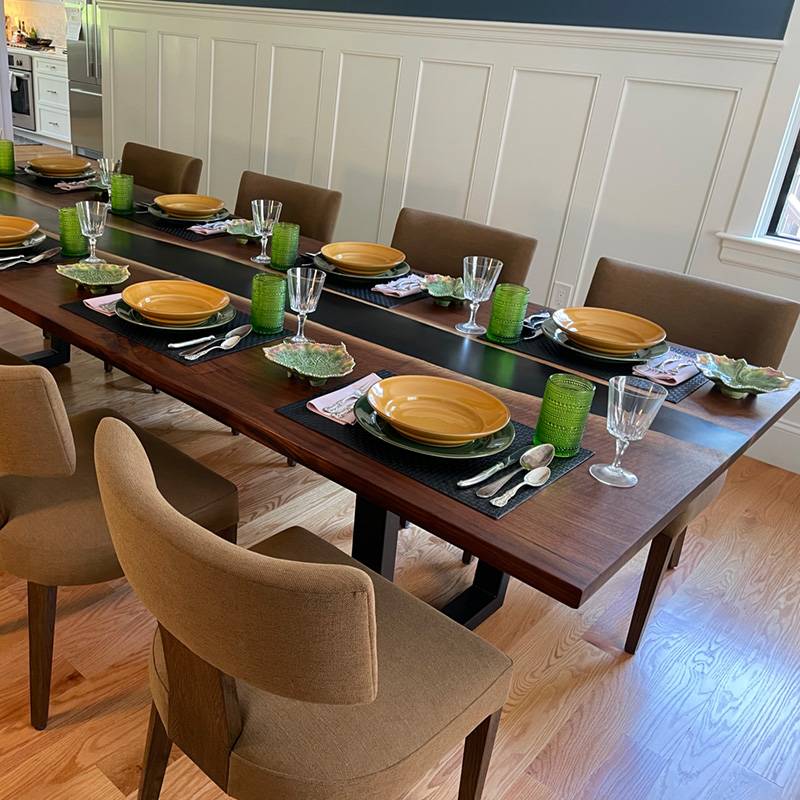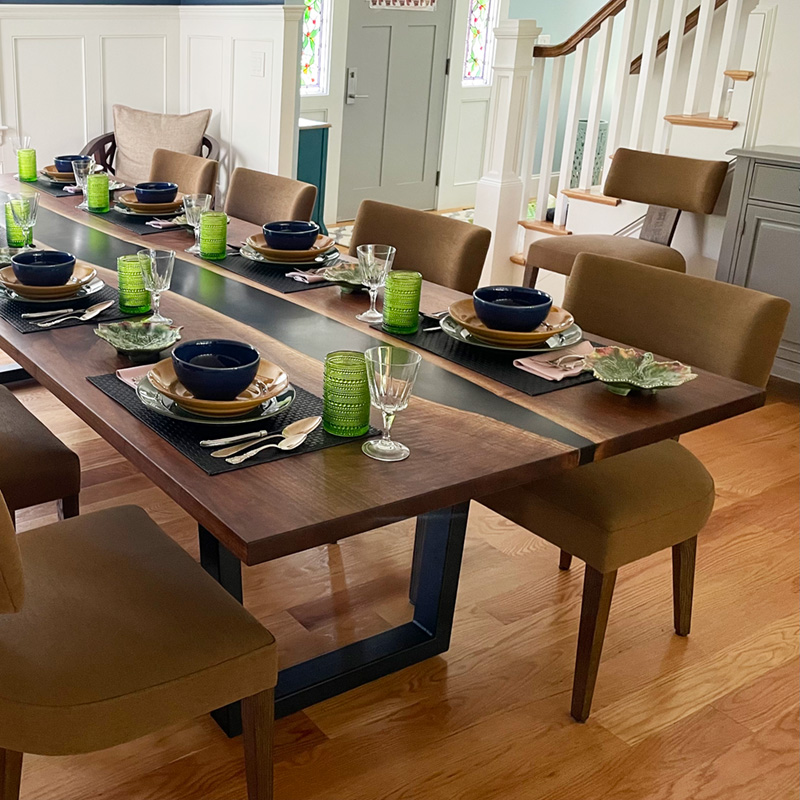This Guide is For You!
If you are considering adding a custom table to your home, office, shop, restaurant, bar, or hotel, this guide is for you. Regardless of the space or application, the information you need is in the following pages.
I have included a description of the process for designing, ordering and taking delivery of a custom table. This is very different than the typical retail shopping experience, but with a little information you will love being in control of the experience.
In these pages, you will also find helpful details about table dimensions that answer common questions like, "How much room do I need around a dining table?" and, "What is the appropriate height for a coffee table?"
This guide is not a long-winded sales pitch. The only marketing content in this guide is right here: I would love the opportunity to work with you to design and build your perfect table. Contact me if you are in New England and want to discuss your vision.
Now, let’s talk about the ordering process for any custom furniture.
The Path to Ownership
One of the most common questions I hear is, “How does ordering a custom table work?” We all know what to expect when we shop for furniture at a store; you pick something from one of a hundred suggested dining room displays, the salesperson takes a payment and tells you when to expect delivery. But ordering furniture crafted just for you is a bit different. Here’s how it works.
Vision and Planning
It all begins with a conversation about your needs and vision. You know how many people you entertain, the space you have, and your own sense of style. If you have inspiration photos, share those with the craftsman. During the design conversations, your vision is translated into a tangible design.
Design into Action
Based on the initial discussions, your builder will prepare a few documents that formalize the plan. These can include drawings or 3D renderings of the design, a detailed quote that shows the cost of materials, labor, and consumables such as joinery hardware and finishing products. Many makers will also send estimated start and end dates and even a contract that protects the interests of both the maker and you. Once there is agreement that the design and price are good to go, some deposit is collected to get the project started in the shop.
Build and Deliver
As the table is created, you should expect updates and photos of the process. Every builder is different, so if you haven’t heard from them in a while, do not hesitate to ask how it’s going.
As the project approaches the finish line, the builder will schedule delivery with you. Depending on the table size, the maker will bring lifting help and do any final assembly in place. Any balance due on the purchase price is collected on delivery.
After the delivery
The craftsperson will discuss furniture care, take some photos, and encourage you to stay in touch. We will probably ask you to leave a review of your experience, too, as every maker depends on these to support their business growth.
That’s it! Owning a custom, solid hardwood table and supporting a local business is just that easy.
Now that you understand the process, let’s address the basics of table size. We’ll look at dining tables first, then coffee tables.
Your Perfect Dining Table
You are ready for a new dining table. Maybe you are redecorating or, perhaps, you are starting with an empty room. There are two big questions: "How big should my new table be?" and "How big can my new table be?"
At the root of these two queries is your vision for the future. Will you host family gatherings? Parties? Fundraisers? Other than the table, how much furniture will be in the room?
How big should my new table be?
The answer to how big should a table be is determined by the number of people you want to seat and the shape of the table. Also, the width of the table should maintain a visually pleasing aspect. This means avoiding oddly shaped, skinny, or pudgy tables.
In general, you can fit the most people around a square table, slightly fewer at a rectangular table, and the least at a round table. However, round (or oval) tables are the best for socializing, followed by square, and rectangles are the least accommodating for conversation.
Table sizes for 6 people
For a rectangular table seating 6 people, the minimum length is 5 feet and width is 36 inches.
The same seating is available in a square table that is 4 feet wide.
Additionally, 6 diners can sit at a round table that has a 5 foot diameter.
Table sizes for 8 people
8 people can sit around a rectangular table with a minimal length of 6 feet and a width around 42 inches.
A square table for 8 checks in at 5 feet wide.
The round table for 8 is 6 feet in diameter.
Table sizes for 10 people
A rectangular table that is 8 feet long and 44 to 46 inches width is suitable for 10 diners.
The 6 foot square table can handle 10 people.
A round table needs to be 7 feet in diameter to allow for 10 guests.
Table sizes for 12 people
A rectangular table that is 10 feet long and 46 to 48 inches wide can seat your party of 12.
The square table needs to be 7 feet wide to handle 12 people.
Mathematically, an 8 foot round table would work for 12 people, but that is a massive beast that puts people in a situation where they cannot reach items served in the middle of the table (even 4 feet is too far away) and they can see guests across the table but need to shout and allow for a brief delay between speaking and hearing (kidding, mostly). A better alternative is probably an oval table that is 9 feet long and 48 inches wide.
Tables for more than 12 people
OK, we are getting into conference table sizes now. Or royal weddings. I will leave it here, but offer that rectangular tables are best for these situations - even if you need to use more than one and arrange them in an L or U shape. You can use the numbers above to figure out how much table you need by adding smaller tables together. For permanent table installations of this size, there are great products to fasten tables together.
How big can my table be?
The answer to this question is relatively straightforward; with chairs tucked in, you should have 36 inches of walking space around the table. This makes moving around the room comfortable rather than claustrophobic. Now, nobody will be checking with the tape measure come dinner time, but your guests will appreciate the space.
Can I go even bigger?
The rule above is a just that - a rule. Made to be broken like all the other rules. To get around the 36" rule, I recommend extension tables. These slide out to allow for adding leaves when your entertaining pushes the boundaries of your capacity. A good problem to have; you are popular and people recognize that you have the definitive entertaining space. Go big! Then, go back to comfortable.
Your dining table is perfect, so let’s consider the coffee table.
Your Ideal Coffee Table
Coffee tables come in many shapes, sizes, colors, and styles. So many, in fact, that it might be confusing what you should be considering or eliminating when it comes to finding the perfect one.
How tall should a coffee table be?
By far the most common questions are about table height. The short is that coffee tables should be between 10 and 18 inches tall. Where your table should be in that range depends on several factors. Let's explore some of these:
- How high is the seating around the table? A coffee table should be somewhere between 2 inches shorter than the seating and even with the seating.
- Will you put your feet up on the table? A taller table can make this uncomfortable.
- Do you want a lower shelf? If so, how much room do you need between the shelf and the table top?
- Do you prefer to reach across for items, or are you comfortable reaching down?
- How tall is other furniture in the room? The coffee table should complement the rest of the room.
How long should the coffee table be?
The rule of thumb for coffee table length is 2/3 of the length of the seating area of the closest couch. You don't need to get overly scientific and calculate out to 3 decimal points, but that general ratio will look good.
How wide/deep should the coffee table be?
You could base the depth of a coffee table on the dimensions of the space and furniture in the room. There is nothing wrong with just finding a table that is a comfortable width give the rest of the room. In fact, if you know the length of the table, your eye will eventually settle on a size that is pleasing to you, and that's perfect.
Interestingly, furniture and interior designers have discovered there is a typical ratio between the length and width that most people find appealing. So, if you are unsure, you can confirm your choice with a little bit of math. The ratio is: length = width x 1.62 or, conversely, width = length / 1.62. From this we can generalize some table sizes to 36x22, 48x30, 54x33, 62x38.
How much space do I need around my coffee table?
The last space consideration, which should probably supersede other factors, is how much walking around space you need to feel comfortable. The absolute minimum is 24 inches. Less than that and you will be bruising your shins and toes forever. 30-36 inches is better. If your room is quite large, keep the coffee table space in this range for the sides of the table that are adjacent to seating. It is always fine to leave a side or two open to the rest of the room.
Why Buy Custom Tables
Get what you want. Buying custom furniture can be a significant investment, but the value of such a purchase makes it a bargain. The style, dimensions, wood selection, legs, apron and finish are all worked out with you and the builder to ensure your vision is realized.
Here are 4 great reasons to build a custom table (or any other furniture) instead of buying from a traditional furniture store. Plus, there is a bonus reason for all of you that read to the end of this section.
Be Unique!
You are not the same as every other person. Our individuality is a big part of what makes each of us interesting. Your decor should reflect your personality in a consistent way. When you are designing or planning a room, you already have a picture in your head of various events, meals, moments and memories that you hope to realize. Now, you need to bring that vision to life with just the right furniture.
Strolling through endless aisles of tables at a furniture store is a disheartening way to discover that the "perfect" table isn't mass produced and in stock. But, many times, settling for one of these choices is exactly what happens.
A factory cranking out the latest "line" of tables is focused on cost and broad appeal.
When I am building a table for a client, I imagine the finished piece in place with a group of my client's friends and family gathered around. Maybe they are having a meal, or a celebration, or just standing around at a party. But the table needs to fit the space and decor and the client's personality and vision.
Color and Material
Imagine visiting the sales desk at a furniture store and telling them, "I love that table, but could I get it in a dark walnut with some figured grain? Maybe a couple knots filled with color?"
That's going to be a quick, hard "No."
When you design a table with a custom builder, these are exactly the conversations we have at the outset. Why not discuss what you love and work toward a design that includes the materials, color, and style that is perfect for you?
Function and Fit
This is the most common reason my clients ask me for bespoke tables. They are frustrated with the selection available at the furniture store because the space they have needs a certain size to work well.
Just sticking a table in a room does not solve every issue. You have in mind what function the table will serve. Dining table, conference table, kitchen table, coffee table, desk, hall or end table. Fulfilling that function in a sensible way for the space you have available is the key to solving both function and fit.
Whenever possible, I prefer to visit with a prospective client to see their space and hear their vision for the finished room. I have frequently taped out a table shape on the floor so we can visualize the space taken and the options for seating, serving, and walking around. In short, we make sure that the custom table will fit and function perfectly before we start building.
One-of-a-kind Top Quality
Buying custom furniture to your specifications from the master builder insures that you are getting a unique product unlike any others. Additionally, furniture stores cannot match the quality of individually crafted bespoke furniture. We pay special attention to every detail, ensuring that the end product is the right size and specification, meets your expectations, and is built for long-lasting quality.
Bonus: Support small business
There is a community of small businesses in your local area that depend on customers who value hand crafted, small batch products. Buying from these shops is a great way to support your community. Additionally, that support helps keep the craft trades going for another generation. Perhaps factory-made furniture is faster and less expensive, but there is value in supporting local craftsman who love making the perfect items for you.
Table Finishes
Every table does not need the same finish. How you intend to use your table, where it will reside, how often the table will be used, and even your climate, all influence which finish should be selected.
Before I get into the different types of finish, I want to mention why we put a finish on the table to begin with. Aesthetically, a finish can enhance the grain and color of natural wood. Without a finish, wood will obviously have a natural matte appearance and texture. Unfinished wood is susceptible to scratches and splintering. We apply finish to create a barrier between the wood and it's smooth, beautiful state and the outside environment. The various finishing options allow us to either maintain a matte appearance or apply either a satin or gloss sheen.
A finish also preserves the wood against the effects of moisture, sunlight, and time. A wood table without finish is completely fine understanding that the wood will move, crack, and change color from brown to yellow and ultimately to gray. Most people don't want that in their fine furniture. Finish products allow for sealing the wood to prevent moisture absorption as well as to provide UV protection.
Given that most people prefer tables that hold their beauty for many years, here is a quick rundown of the various finish options.
Oils and Waxes
Oils and finishes that combine oils and wax are very common, durable, and beautiful. For many tables, this type of finish is desirable because it enhances the natural beauty of the wood, and is easy to maintain and repair.
Simple boiled linseed oil can be applied to wood and allowed to penetrate. This creates a waterproof barrier. However, this simple finish is probably not suitable for heavy use, and is not the most beautiful. Personally, I do like to apply linseed oil to the underside of tables because it has great protective qualities and is very low cost. Also, most people don't spend a lot of time looking at the bottom of their table.
There are several competing products which combine oils with a cured wax finish.
These have all the benefits of a penetrating oil, and add the
durability and sheen of wax. These products also preserve the natural feel and appearance of the wood. The majority of the tables I build are finished with this type of product. I prefer Rubio Monocoat. It is available in a "pure" color, or it can be colored to create darker or more colorful finishes.
Oil/wax finishes are suitable for most residential, indoor tables. Because it is wax, hot items should not be placed directly on the finish.
Polyurethane
Leveling up from oils and waxes, polyurethane offers a greater measure of barrier protection. This is a film finish that completely seals the wood, creating a durable, waterproof, heat and scratch resistant coating.
Poly is available in water- and oil-based versions. Water-based poly is fast drying and multiple coats can be applied in one day. Oil-based poly can take 2 or 3 days to dry between coats.
Polyurethane offers matte, satin, gloss, and high gloss finishes.
The durability of poly makes it a good choice for heavily used tables.
Repairing polyurethane is done by giving the surface a quick sanding to level out any defects then brushing or spraying a new layer.
Oil based polyurethane or spar urethane with UV protection are good choices for outdoor furniture that will be exposed to the Sun and weather.
Shellac
Shellac is a natural resin. It is derived from plants or insects. That may sound a little gross, but the end result is stunning.
Shellac can be purchased in liquid form or as "flakes" that are dissolved in alcohol then rubbed into the wood. As the shellac is built up and rubbed, the level of sheen can be controlled. Shellac is suitable for indoor tables, but it is not heat resistant and care must be taken to avoid placing anything hot directly on the finish.
Lacquer
Lacquer is a quick drying resin that produces a hard, durable surface. Like polyurethane, lacquer is available in water-based and solvent-based formulas. Water-based lacquer is less toxic and easier to clean up than solvent-based lacquer, but the finish is not as durable.
Lacquer is heat resistant, making it a good option for use on dining tables.
A lacquer finish can give wood a beautiful, deep shine. It is also one of the most durable finishes available, making it a good choice for high-traffic areas such as dining tables.
Those are the basic finishes used in custom furniture. Talk with your builder to determine which will work best for your vision and use.
Cost and Construction
Is a custom table out of your reach? Probably not if you are considering buying from a traditional furniture store. The price can be comparable, but the cost for custom reflects the wood selection and craftsmanship rather than importing and shipping, marketing, commissions, overhead and other expenses that need to be covered at the big store.
How much does a custom dining table cost?
Let's answer the toughest question first. You may believe that custom tables must be wildly expensive, but that does not have to be the case. It is certainly possible to design a table that costs upwards of $10,000 or more, but it is equally possible to make decisions that allow a similar table to be built for much less.
How much less?
Being truthful, you should not expect that custom tables of any kind will beat the price of a mass-produced table in a heads up, like-for-like design. But getting a modest table built from domestic hardwood for $2500-$3500 is a reasonable goal.
The cost of a custom dining table is a reflection of the unique elements that go into its creation. Several factors influence the price, including the choice of materials, the specific wood selection, the complexity of the design, the table's size, and the time invested in its preparation and construction. Each decision made during the crafting process contributes to the overall value and individuality of your custom table. Rest assured, the resulting custom table will not only be a testament to quality but also a representation of your personal style and preferences.
How is a custom table designed?
Exceptional table designs stem from a harmonious blend of various elements, with the foremost being the unique vision and expectations of the customer. We all possess distinct reasons for desiring a custom table, whether it's about bringing a vision to life for hosting home events, optimizing space utility, or seamlessly integrating a table into an overarching design.
Collaborating with a skilled furniture designer or craftsman is the ideal route to fuse your vision with professional expertise. Come prepared with images of tables that resonate with your taste (or those that don’t) while the craftsman shares their portfolio and skills. To further enhance the process, an in-person visit to the designated space where the table will reside is invaluable. While a virtual visit is an alternative, nothing quite matches the depth of an in-person encounter. This visit, typically lasting 30-60 minutes, serves as a crucial exploration of style, vision, scale, and the initial decision-making on materials. It serves as the catalyst for the subsequent steps in the design process.
Wood selection
Selecting a wood species is a critical step. The type of wood determines the natural tone or color of the table. Any stain or shading or accents will vary in their effectiveness depending on the main wood choice. Most colorants work by embedding pigment in the wood grain, so selecting a wood that has very fine or subtle grain (like maple) will produce one result, but selecting a wood with strong grain (like walnut or oak) will produce a very different result.
The wood selection obviously impacts the cost of a custom table. Since 2020, most hardwoods have seen dramatic increase in cost. Working with a craftsman can help making the right choice easier. If you have ever bought countertops or carpets, you'll know that those are typically priced on a "per square foot" model. Hardwoods are different because the thickness of the wood is variable and the overall volume of wood needed is part of the cost. So, wood used in furniture making is sold in "board feet." This is much like buying cords of firewood. A board foot of wood is 12 inches by 12 inches by 1 inch.
If a particular species of wood is selling for $40 per board foot, here are some examples of typical cost to the builder:
- 66 x 30 x 1.5 = 20.62bf -> $825
- 72 x 36 x 1.75 = 31.5bf -> $1260.00
- 96 x 40 x 2.0 = 53.33bf -> $2133.34
Once the initial ideas are discussed and the wood and material decisions are made, a drawing or rendering is made to define exactly what is to be built. This illustration becomes the basis for building a price quote.
How is a custom dining table built?
Building a table is a relatively straight-forward process. The design process has already defined the size of the table and the principle materials to be used. Therefore, construction is broken down into three main areas, each of which follow a similar process.
The three main parts of table construction:
Table top
The top is either assembled by milling and joining multiple boards together, or by milling one or more large "slabs" to create a natural, live edge detail. The result will be a long and wide panel that is roughly flat and ready for treatment (filling knots and cracks, addressing any stability issues, and adding any inlaid details) and finishing (sanding smooth, addressing color, adding a protective finish with the desired sheen/appearance).
Apron
If applicable, the apron is a short detail that is mounted under the table top and runs around the perimeter of the top and connects the legs. The apron can be simple or ornate or even omitted entirely. The apron goes through similar steps as the top including milling, treatment, and finishing.
Legs
There are almost limitless choices for table legs. For budget-minded customers, buying pre-made legs is a great way to save big money. Adding custom legs can increase the table cost significantly as this is where complex design can easily add a lot of time to a project. Legs are typically either metal or wood, and legs can be set up as a single pedestal, two or more trestles, or four single post legs.
Conclusion
Crafting a custom dining table is an artful journey that begins with your unique vision. The building process starts with a thorough consultation, where we delve into your desires for size, style, and statement. From there, the craftsperson meticulously selects the finest materials, carefully considering wood type, grain patterns, and finish options to match your preferences. Each part of the table is built with an eye toward durability and beauty. Quality checks and finishes are applied, resulting in a one-of-a-kind piece that not only reflects your individuality but also stands as a testament to the maker’s passion for excellence. Your custom dining table, a true labor of love, is ready to become the heart of your home.

